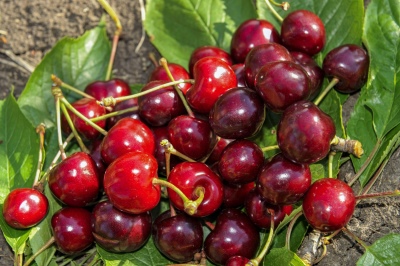
- Fruit shape: heart-shaped
- Keeping quality: stored for up to several months
- Growth type: vigorous
- Appointment: for all types of processing, for fresh consumption
- Yield: high
- Tree height, m: 4-5
- Crown: spherical, lush, branched
- Sheet: large elongated
- Fruit size: large
- Fruit weight, g: 9,6
Sweet cherry is one of the favorite fruits. From the end of May to August, rich red and yellow berries on store shelves constantly tempt us. Sweet cherry Talisman to this day is considered one of the best varieties for growing on an industrial scale. An unpretentious variety in cultivation, which gives a huge harvest every year.
Breeding history
The mascot was bred by Ukrainian breeders in 1956. The varieties Drogana Zheltaya and Valery Chkalov were taken as the basis. Cherries are grown up to the 6th zone of frost resistance with a minimum temperature of -23 degrees.
Description of the variety
The tree is vigorous. On average, the height of a sweet cherry reaches 4-5 m, a maximum of 6 m. The plant develops rather quickly with a good annual growth of young shoots. Therefore, his crown is spherical, branched and very lush. The twigs grow strong, light brown in color. Leaves of a rich green color, strongly elongated. Inflorescences are formed on the shoots of this year. The flowers are large, bouquet-like.
Gardeners note the following advantages:
stable fruiting;
high taste;
persistent immunity to most diseases;
frost resistance;
high yield rates;
amicable ripening.
The breeders sought to create a variety capable of growing in various climatic conditions, giving stable yields with minimal maintenance. Therefore, gardeners practically do not notice any shortcomings.
Fruit characteristics
The talisman has very large heart-shaped fruits. The weight of one berry can reach 9.6 g. If there are not very many fruits on the tree, and the agrotechnical conditions are observed, then specimens can reach 15 g. The color of a ripe cherry is rich maroon. The rind is shiny and thin, yet well separated from the pulp. The bone is separated well. The harvested fruits can be stored for quite a long time, about several months.
Taste qualities
Sweet cherry Talisman has a sweet taste with a pleasant sourness in the aftertaste. With thin veins, the flesh is very juicy, sugary, melting in the mouth. On a five-point tasting scale, the Talisman is rated at 4.9 points. The fruit contains a large amount of sugar - 15.5%, fruit acid 5.52%, dry fractions - 23.6%. Basically, sweet cherries are consumed fresh, they also make delicious and aromatic jams for baking, compotes and more.
Ripening and fruiting
A variety of medium ripening. The fruits begin to ripen at the end of June. The tree begins to bear fruit in the 4th year of planting.

Yield
The culture is high-yielding.Up to 71 kg of fruit can be harvested from one tree. Transportability is good, the harvested crop does not lose its presentation and taste for a long time.
Self-fertility and the need for pollinators
The variety is self-fertile. Therefore, a pollinator companion must be planted next to the tree to harvest. The best species for this are Valery Chkalov, Aprilka, Skorospelka.
Growing and care
Growing a sweet cherry Talisman on your site will not be difficult. The main thing is to plant the plant correctly. For this, they choose the sunniest place, since the culture needs the sun to get large and sweet fruits. The variety is not particularly picky about the composition of the soil, but it feels comfortable on neutral and slightly alkaline soils. Clay soil is enriched with sand and peat.
To increase the fertility of the soil, every year, starting from 3-4 years of planting, it must be enriched with compost or humus, as well as nitrogen, phosphorus and potassium, necessary elements for the successful development of the culture.
It should be taken into account that groundwater does not pass close to the site, where the tree will grow. Excessive moisture in the roots most often leads to the development of various infections. Planting is preferable in spring, during which time the plant will have time to take root and successfully endure frosts.
Before planting a tree on the site, it must be prepared. The place is carefully dug up, weeds, roots are removed, mineral and organic fertilizers are applied. Before planting, the seedling is soaked in a solution that stimulates rooting for a day. A hole is dug in advance with a depth of 40-50 cm and a width of 60-70 cm. The pollinator variety is planted at a distance of at least 4-5 m from the Talisman.
The seedling is carefully placed in the hole, carefully straightening the roots. The hole is covered with soil mixture, tamped and watered abundantly. The junction point of the scion and rootstock should be 5 cm above the ground. If the site is heavily blown by the wind, then you need to install a peg, and tie a seedling to it so that it does not break.
The first month the seedling is watered 2 times a week for successful rooting. For less moisture loss from the soil, a layer of straw or dry grass mulch is laid around the trunk.
Crop care consists in regular irrigation, top dressing and constant pruning of the crown thickening.





































































